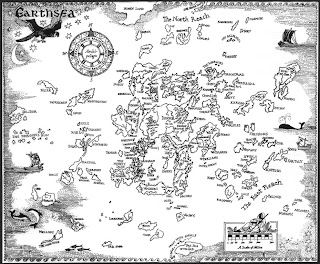
- "Fantasy is a game of sorts, a violation of convention and natural law and a representation of impossibilities for which have no place in the world we know as real."
- The impossible nature of this type of story can be proclaimed through any number of means: for example, the presence of magic, fanstastical creatures such as dragons, articulated inanimate objects... - "By demanding a straightforward treatment of impossible characters, objects or events" with a consistancy that ensures that the reader and writer of fantasy is committed to maintaining the illusion throughout the entire course of the text.
- "Any narrative which includes as a significant part of its make up, some violation of what the author clearly believes to be natural law-- that is fantasy." It is, in essence, the fundamental alteration of reality.
- "One of the most important elements that fantasy can aim to give is comprehensible form to life, death, good and evil" - through storylines that can calrify philisophical and moral conflicts while not being directly applicable to our own lives.
- "Fantasy invokes wonder by making the impossible seem familiar, and the familiar seem new and strange." (Attebery, 1980).
Here's what I came up with when comparing Le Guinn's A Wizard of Earthsea with Atterbury's definitions: Firstly, to disocate the reader from their world, there is a map included with the story. This helps to create the illusion of Earthsea as another place so that there is no way that it might be confused with the world we already inhabit. The way that Earthsea is illustrated within the text harks back to folklore and simpler medieval times where peasants wore robes, lived off the land and cooked over open fires in huts with no electricity or other technology. Ged's father is a blacksmith and as their village is about to be invaded, his basic weapons are all they have to fend off the enemy, that is, until Ged uses a spell to create fog in an attempt to confuse them. The simplicity of a world without complicated modern trimmings allows magic and those who posess it to have a significant and controllable role in society that would perhaps be occupied by other great powers that we are familiar with- such as politics and the politicians who have the power to create laws. Thus, as a wizard, Ged not only holds a lot of power but he has a responsibility to use it in a way that will benefit others. This responisbility is challenged early in the text when his arrogance and relative naiivity gets him in trouble and almost destroys him. Ged's growth and developement in the text are heavily reliant on those things that are not real in our world, but are consistant within the world of Earthsea- he grapples with dragons and dead spirits and through these challenges and losses he learns responisibility and takes on the role of the hero within the story.
References:
Attebery, B. (1980). The Fantasy Tradition in American Literature: From Irving to Le Guin. Bloomington: Indiana University Press, 1-10.
Le Guinn, U. (1993; 1968). A Wizard of Earthsea. In The Earthsea Quartet (pp.13-167). London: Penguin.
